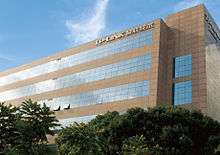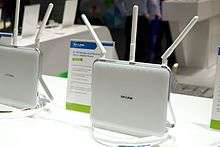TP-Link
 Logo as of 2016 | |
 TP-LINK Global Headquarters in Shenzhen, China | |
Native name | 普联技术有限公司 |
|---|---|
| Private | |
| Industry | Networking equipment |
| Founded | 1996 |
| Headquarters | Shenzhen, Guangdong, China |
Area served | Worldwide |
Key people | Jeffrey Chao (Chairman) |
| Products | Ethernet hubs, Routers, DSL/Cable Gateways, Switches, Wireless Access Points, Storage and security IP cameras |
Number of employees | 21,849 (Dec 2013) |
| Subsidiaries | Neffos |
| Website |
www |
TP-Link (simplified Chinese: 普联技术; traditional Chinese: 普聯技術; pinyin: pǔ lián jì shù, stylized as tp-link), is a Chinese manufacturer of computer networking products based in Shenzhen, Guangdong, China.
History
TP-Link was founded in 1996 by two brothers, Zhào Jiànjūn (赵建军) and Zhào Jiāxīng (赵佳兴), to produce and market a network card they had developed. The company name was based on the concept of "twisted pair link", a kind of electromagnetic cabling, hence the "TP" in the company name.[1]
TP-Link began its first international expansion in 2005. In 2007, the company moved into its new 100,000 square meters headquarters and facilities at Shenzhen's Hi-Tech Industry Park. TP-LINK USA was established in 2008.[2]
In September 2016, TP-Link unveiled a new logo and slogan, "Reliably Smart"; the new logo is meant to portray the company as being a "lifestyle"-oriented brand as it expands into smart home products.[3][4]
Product ranges

TP-Link products include wireless routers, mobile phones, ADSL, range extenders, routers, switches, IP cameras, powerline adapters, print servers, media converters, wireless adapters, power banks, and SMART home technology devices. TP-Link also manufactured the OnHub router for Google.[3] In 2016 the company launched the new brand Neffos for smart phones.[5] TP-Link manufactures smart home devices under their Kasa product line.[6]
TP-Link sells through multiple sales channels globally, including traditional retailers, online retailers, wholesale distributors, direct market resellers ("DMRs"), value-added resellers ("VARs") and broadband service providers. Its main competition includes companies such as Netgear, Buffalo, Belkin, Linksys, D-Link and Asus.
Manufacturing
TP-Link is one of the few major wireless networking companies to manufacture its products in-house as opposed to outsourcing to original design manufacturers (ODMs). The company says this control over components and the supply chain is a key competitive differentiator.[7]
Vulnerabilities
Computerworld reported in January 2015 that ZynOS, a firmware used by some routers (ZTE, TP-Link, D-Link and others), is vulnerable to DNS hijacking by an unauthenticated remote attacker, specifically when remote management is enabled.[8]
References
- ↑ "Network-gear firm TP-Link thinks big in US market|Across Americas|chinadaily.com.cn". Usa.chinadaily.com.cn. 2013-04-05. Retrieved 2014-03-07.
- ↑ Richard Xu (2013-09-15). "Richard Xu, Vice President - TP-Link". Businessinterviews.com. Retrieved 2014-03-07.
- 1 2 "TP-Link Transforms From Purveyor of Fine Tools to Smart Life Enabler". CNET. Retrieved 28 September 2016.
- ↑ "Introducing The New TP-Link®-TP-Link Unveils Completely New Look and Brand Identity". TP-Link. Retrieved 28 September 2016.
- ↑ "NEFFOS PHONES". Gadgets 360.
- ↑ "Smart Home | TP-Link". www.tp-link.com. Retrieved 2017-09-16.
- ↑ "TP-LINK Targets Aggressive U.S. Expansion, VARs Included". CRN. Archived from the original on 5 January 2012. Retrieved 2014-03-07.
- ↑ Constantin, Lucian (2015-01-27). "DNS hijacking flaw affects D-Link DSL router, possibly other devices". Computerworld. Retrieved 2018-03-24.